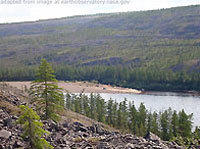Russian government selects Far East development model

KHABAROVSK. Oct 29 (Interfax) – The Russian Far East Development Ministry has put together a model for the Far East that will establish a network of export oriented zones in the region. Other ministries have not yet reached a consensus on this issue, but Prime Minister Dmitry Medvedev has already issued some instructions.
Export to Russia irrational
In a meeting last week of the government commission on socioeconomic development of the Far East, the prime minister said developing the export potential of the Far East is one of the priorities of the strategic development model for the region.
“Developing export potential, exports to Asia Pacific countries, the creation of new production, aimed at this market – this is one of the versions for regional development,” he said.
Far East Development Minister Alexander Galushka says the export direction of the Far East economy is the only true model of economic development for the region, because it has a very narrow domestic market, and aiming for the European part of Russia is not rational because of its remoteness and high expenses.
New term
Based on the opportunities of the Asia Pacific countries together with the competitive advantages and shortcomings of Russia’s Far East, Galushka proposed developing a network of ‘priority development export territories.’ These could be special economic zones, industrial, technology and agriculture parks with competitive advantages compared to neighboring countries.
The ministry has already put together a model for priority development export territories with a set of terms that might attract investors to such a zone. These include income tax of 10%, salary tax of 7.65%, profit tax of 10.3%, zero duties, property tax and VAT.
In addition, the cost of labor resources in the priority development model should be the same as in China ($16,300 annually per head), the cost of electricity should be like in South Korea ($0.054 per kilowatt hour), and spending on transportation – like in Singapore ($439 on average per exported container).
“Priority development export territories in the Far East should provide the best range of conditions for investment projects, which will require special regulation, right up to introducing another type of special economic zone for exports,” ministry materials drafted for the meeting showed.
Current Russian SEZ are not competitive in the Asia Pacific Zone, largely due to high expenses on transportation ($1,800 on average per exported container), high profit tax (13.5%), and also high administrative spending and weak export support measures.
Development institutes
For the priority development territories to function successfully and to overcome the shortcomings of the general SEZ, Galushka suggested the formation of four development institutes, coordinated by the Far East Development Ministry.
The East Russia Development Corporation should provide quality development of priority export territories, attracting and allocating investors.
The Far East Investment Raising Agency should work in parallel with the corporation. It will work to create a favorable and recognizable image for Russia’s Far East among investors, to create a comfortable information environment amid the implementation of specific projects and encourage the promotion of exports.
The existing Far East Development Fund, part of VEB, should be used as a source of non-government international financing. The fund should also undertake some mutual risks involved in infrastructure projects with the participation of foreign investors.
Finally, the fourth institute should be the Human Capital Development Agency. A key task for the agency will be to handle the deficit in the population and personnel. Labor resources will be attracted from other Russian regions and Ukraine.
Unnecessary Complication
Deputy Finance Minister Leonid Gornin said in a letter to the government, which Interfax has a copy of, that the proposal for new development institutes requires a financial feasibility study.
“The creation of new development institutes along with the existing institutes without the specified analysis could lead to an unnecessary complication in the system of government management and inefficient budget spending,” he said.
Crating a single structure would prevent the dilution of responsibility and provide flexibility in financial resource management. Some of the task could be carried out by the Far East Development Ministry itself and part by Rostruda and regional authorities.
Deputy Natural Resources Minister Denis Khramov said he was not sure about the idea of directing Russia’s Far East to Asia Pacific countries.
“The export strategy in terms of replenishing the mineral material base (a(euro) ) is not optimum: the announced level of subsoil resource production cannot be ensured with the existing and planned infrastructure,” Khramov said about Galushka’s proposal.
“Production of mineral resources should first and foremost meet our own industrial, food and other needs.”
“The proposals put forward by the Far East Development Ministry violate the uniformity of approaches to the SEZ and territorial development zone system,” Deputy Economic Development Minister Oleg Savalyev said in a letter, which Interfax has a copy of.
The Economic Development Ministry’s authority in regulation of SEZ is set out in the relevant law so it cannot go the Far East Development Ministry.
However, Savelyev’s tough stance on SEZ was compensated by a softer proposal to set up a working group on the setting up of development institutes and to draw up a model of development for the Far East.
Results
At the end of the session, Medvedev gave instructions for other ministry to submit proposals on Far East development to the Far East Development Ministry, Deputy Prime Minister and Presidential Envoy in the Far East Federal District Yury Trutnev told the press.
“The Far East Development Ministry needs to be re-formatted as it does not have any real functions right now,” he said.
